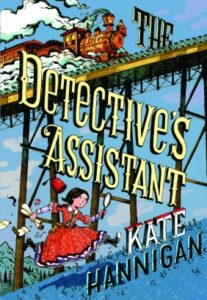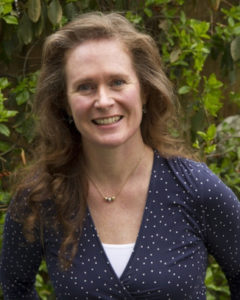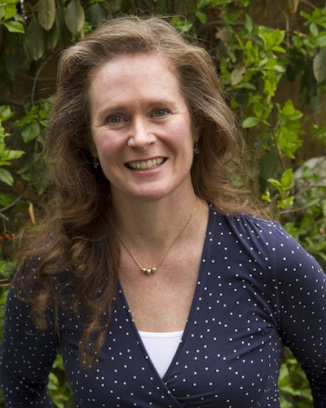We had the pleasure of having Kate Hannigan, author of The Detective’s Assistant, join our group by Skype from Chicago for our April in-person middle grade discussion. We got to ask all our pressing questions about her writing process and incorporating research–and even how she keeps all her research organized! She graciously agreed to share some of her answers and tips with you here. Enjoy!
KidLit Craft: What inspired you to write The Detective’s Assistant?

The Detective’s Assistant by Kate Hannigan (Little, Brown, 2015)
When I first stumbled across just a paragraph about Kate Warne and Allan Pinkerton—about how she’d walked into his office in 1856, he assumed looking for a secretary position, but then she talked him into hiring her as a detective—I was hooked. I dropped the manuscript I was working on and ran with Kate Warne. I’d never heard of her, and when I dug into her story and learned that she’d played a role in thwarting an assassination plot against Abraham Lincoln, I was bowled over. I immediately thought that other people should know about her, especially girls. It’s so important for kids, boys and girls, to see that women played a role in shaping our country too. That they were daring and courageous and bold, just like men.
Can you give us a brief overview of your process from idea to publication?
I don’t know that I have a true process! What I usually do is take long walks and mumble to myself. When I feel like I have a good idea, I see if anyone has already beaten me to it—I come from newspaper journalism, and nobody in newspapers likes to get scooped! If not, I try to write the general sense of what my book would be about. I guess it’s like writing the jacket flap copy. My goal: when my agent or editor considers my pitch, it is clear enough that they can go down the hall and make a strong case for it.
The actual writing of the book can be ugly. I outline. I am a reformed pantser, now a zealot about outlining. Once I get that laid out, I start sketching story arcs so that I can clearly see who is going where and what their growth is by the end. And I can think about how they interact. And then I make myself nuts for about a full six months, never bathing enough, drinking gallons of mint tea, taking more long walks where I mumble to myself in public. It’s an excruciating process that I wouldn’t recommend to anyone! But at some point, the steaming hot mess becomes a Thing. And the Thing takes shape. And then I get past that fear Anne Lamott writes about in Bird by Bird—about praying that you don’t get run over by a car and people see how dreadful your early manuscript is! And then I just keep revising and layering in threads and things. I think I read one time that John Irving revises his books about 1,000 times. I’m not quite to that many, but there is a lot of retooling and refining.
Do you have a structure that you use to develop your characters and plot?
I usually just wrestle with the plot using pencil and paper. But when it comes to characters, I put them on the couch and find out about their childhoods! There are lots of good tools online, like here, but I find myself a good interview document and get busy thinking about my main character’s likes and dislikes, dreams, hopes, quirks, all that I can. For me, filling out an entire profile sheet can really help me flesh out who my characters are and maybe layer in some humanity. People are complicated, so our characters should be too. Once I have a handle on who one character is, I fill out a questionnaire for another one, and I can start to see how they relate to each other, or things one of them does that might really annoy the other.
Given your historical setting and characters, how did you keep track of all the historical data so that you weren’t constantly re-looking up things?
I read obsessively. I read everything I could find about Kate Warne, and I studied the Baltimore Plot like it was finals week. Or finals year. And I drew charts, timelines that showed what was happening in the world as my characters moved toward their big moments. I taped things to my walls, I kept notebooks, I had sticky notes all over the place. I kept files on my laptop, but I also benefited from pencil to paper charts too. And I always had my reference books handy so that I could double-check myself. I tend to purchase the books I use the most in my research, so that I can highlight passages and tape tabs to the sections that contain the meatiest information. And I worry a lot, so that’s a big motivator that forces me to take the time and go back over the facts to make sure they’re right!
How did you go about making your characters and setting feel historically accurate both from a timeframe and a cultural perspective?
I read, read, read. I read Uncle Tom’s Cabin (published in 1852) to get a sense of the language used around the time my book is set in the late 1850s. I read Sister Carrie to get a sense of women trying to survive in the city. Thank heavens for graduate students, because there are dissertations on every subject you can think of! I read a book on the history of underclothes to see how many layers my characters would be wearing, histories of boarding houses to understand what life might be like living in one. I used an online etymology dictionary (www.etymonline.com) to make sure my word choices were true to the times. And I looked at Chicago newspapers and magazines like Godey’s Lady’s Book from the period to see how language was used and what people were talking and reading about. It was a lot of fun!
What is next on the horizon for Kate Hannigan fans?

Kate Hannigan, author of The Detective’s Assistant
I’ve spent the past two years researching and writing a book set during World War II. There were some pretty remarkable women who lived then. Women who, like Kate Warne, were breaking barriers and at the center of nail-biting action. I’ve had a whole lot of fun with this story, and I only hope my editor thinks it’s fun too! We’ll see what happens with that novel. I also have two picture book biographies about remarkable women coming with Calkins Creek, the U.S. history imprint of Boyds Mills Press. The first, titled A Lady Has the Floor, comes out in early 2018 and is about Belva Lockwood, the first woman on the ballot for president. The second book is titled Margaret Builds a Museum, and it’s about Margaret Burroughs, an artist and school teacher who created the first museum of African American history—in her living room!
Thanks, Kate, for sharing about your writing and research. For more about Kate and her work, check out her website and The Detective’s Assistant. See a photo of Kate Hannigan at Kate Warne’s grave in this Chicago Tribune article about her.
Kristi Wright (co-editor) writes picture books and middle grade novels. Her goal as a writer is to give children a sense of wonder, a hopefulness about humanity, and a belief in their future. She is represented by Kurestin Armada at Root Literary. She is an active volunteer for SCBWI and a 12 X 12 member. Find her at www.kristiwrightauthor.com and on Twitter @KristiWrite.


I’ve so enjoyed your resourceful and inspiring interview, Kate! Especially after reading your book. 😉 I’ll be sharing it and saving the link for tips when I begin my next historical fiction novel. Thanks!